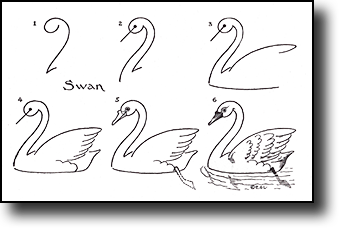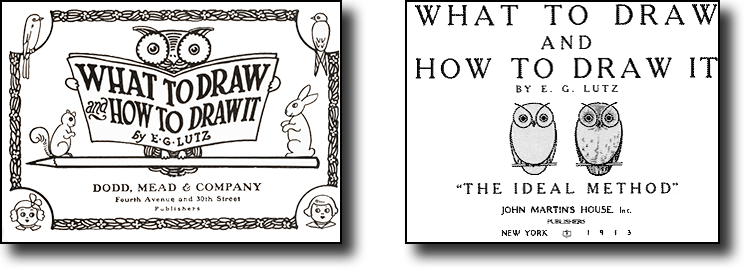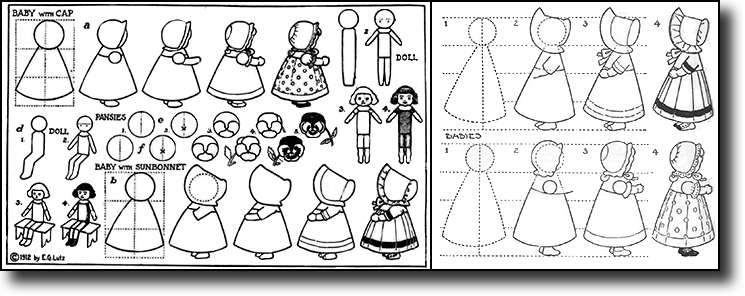
In 1913, at the age of 45, Edwin started a new career as a book author. He wrote 17 books between 1913 and 1936 under the name “E.G. Lutz.” They were instructional how-to books covering a variety of forms of drawing and art. Edwin’s body of work shows that he had a wide breadth of knowledge on many aspects of his profession.
Before the First Book
Before Edwin published his first book, he contributed to newspapers and magazines. In 1912, he wrote a series of articles under the title “HOW DRAWING IS MADE EASY FOR EVERYBODY.” This appeared in the Sunday’s “Boys’ and Girls’ Page” section of The Sun newspaper starting around January 1912. This series became the foundation for the books What to Draw and How to Draw It and Drawing Made Easy.
Below shows an art proof, found in the family records, on the left. The handwriting at the top says “(Not for public view until Feb 18).” The February 18, 1912 published version appears to the right.

Edwin not only registered copyrights for the series of articles, but also copyrighted a work titled Drawing Made Easy in 1912. This was probably a booklet or pamphlet, since it was registered under the category “Pamphlets, Leaflets, Contributions to Newspapers or Periodicals…” in the Library of Congress. Also, it’s initial selling price was 25 cents, while his books typically sold for two dollars or more. It is assumed that this work included the content from the newspaper series. However, a copy of this booklet has not been discovered.

What to Draw

What to Draw and How to Draw It (1913) was Edwin’s first published book. While the content is not identical to that used in the newspaper series, “HOW DRAWING IS MADE EASY FOR EVERYBODY,” the artwork has many similarities. The book primarily consists of sequenced illustrations that provide step-by-step instructions on how to sketch a figure. His audience was the beginning drawer. The only text in the book appears at the end, where the subjects of “Drawing Ovals and Ellipses” and “Suggestions for Water-color Painting” are briefly discussed.
On his first outing as a book author, Edwin initially self-published What to Draw and How to Draw It. The Lutz family has two copies of this book. In one copy, the area on the title page that shows E.G. Lutz as the publisher is covered by a hand-written label: “Dodd, Mead + Co.” It is possible that Edwin had these books printed so that he could use them to shop around for a publisher.

Edwin registered the copyright with himself as the publisher (“Weehawken, N.J., E.G. Lutz, 1913”).

To make things even more interesting, Alex Jay (Tenth Letter of the Alphabet blog), has found that the same book was published in 1914, first by John Martin’s House, Inc. and, several months later, by Dodd, Mead & Company. Why were there two publishers? Why didn’t the publishers require exclusivity? There seems to be a mystery surrounding Edwin’s first experiences as a published book author.

Practical Drawing
Practical Drawing (1915) was targeted to a more mature audience than his first book was. The later book covered a wide variety of drawing topics, including human figures, charcoal/crayon drawing, water-color painting, pen and ink drawing, geometry, composition, lettering, costume design, and other miscellaneous drawing topics.

Drawing Made Easy
Drawing Made Easy (1921) was probably Edwin’s most popular book. It was very similar to What to Draw and How to Draw It in that it offered step-by-step instructions on how to build a sketch of a figure, and it was targeted to young artists. However, this later book includes written instructions and helpful tips for each drawing.

right: Modern Canadian Library, 1972)
As mentioned earlier, some of the content of Drawing Made Easy was taken from the “HOW DRAWING IS MADE EASY FOR EVERYBODY” newspaper series in 1912. Below is a comparison from the two publications.

right: Drawing Made Easy, 1921)
As artist and author James Gurney discussed in his blog post Drawing Made Easy, Edwin’s method for teaching drawing was used in the 19th Century by French art schools (e.g., the École des Beaux-Arts). Perhaps this is not surprising, since Edwin attended Académie Julian in Paris in 1900 to study art. (Julian was a private arts school, run in part to prepare students for entrance to the École.) Using this technique, the artist (and student) starts with large basic forms and progressively refines them by adding smaller shapes and detail.

Bibliography
Below is a list of the books Edwin wrote, including the year of each work’s initial copyright registration.
- What to Draw and How to Draw It (1913) – The Ideal Method.
- Practical Drawing (1915) – A book for the student and the general reader.
- Practical Art Anatomy (1918) – Structural anatomy of the human figure easily understood by ingeniously drawn diagrams.
- Animated Cartoons (1920) – How they are made, their origin and development.
- Drawing Made Easy (1921) – A helpful book for young artists.
- Instead of Scribbling (1924) – A guide to pencil drawing, a drawing book for young people.
- Practical Graphic Figures (1925) – The technical side of drawing for cartoons and fashions.
- Practical Pictorial Composition (1926) – A guide to the appreciation of pictures. With pen-and-ink interpretations of paintings and diagrammatic analysis by the author.
- The Motion-Picture Cameraman (1927) – A book for the amateur and professional cinematographer.
- Practical Pen Drawing (1928) – A clear presentation of pen-and-ink illustration.
- More Things to Draw (1928) – A sequel to Drawing Made Easy. A helpful book for young artists.
- Practical Art Lettering (1929) – A treatise on the construction of the symbols of the alphabet.
- Practical Landscape Paintings in Oils (1930)
- Animal Drawing in Outline (1931) – A drawing book for young people.
- Practical Water-color Sketching (1931) – With specific instructions for making wash drawings in color and black and white.
- Practical Engraving and Etching (1933) – A book of instruction in the art of making linoleum blocks, wood-engravings, wood-cuts made on the plank, etchings and aquatints.
- Practical Course in Memory Drawing (1936) – For the classroom and for self-study.
